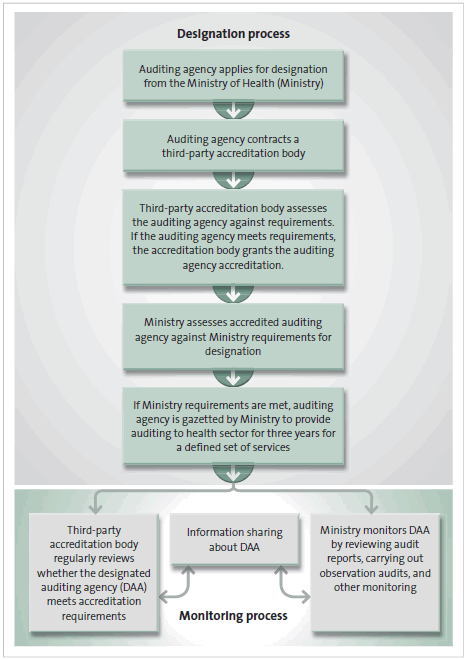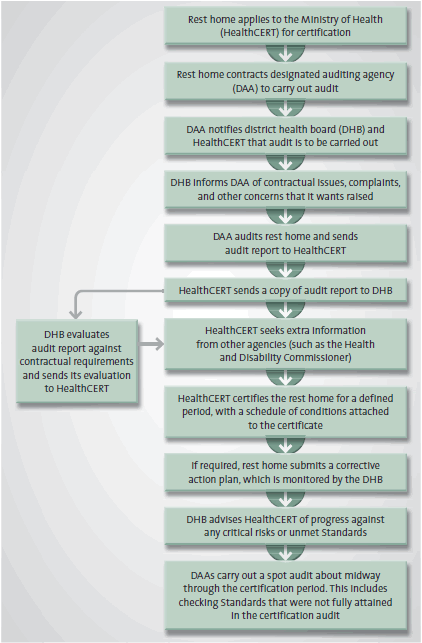Part 2: The Ministry has changed its processes for designating auditing agencies and for auditing and certifying rest homes
2.1
In this Part, we describe:
- the process for designating auditing agencies (and how this process has changed since 2009); and
- the process for auditing and certifying rest homes (and how this process has changed since 2009).
The process for designating auditing agencies
Background
2.2
The Health and Disability Services (Safety) Act 2001 (the Act) requires rest homes providing health care services for three or more residents to be audited and certified by the Director-General of Health (the Director-General) to ensure that they are providing safe and reasonable care that meets the Standards.
2.3
The Act requires the Director-General to designate agencies (DAAs) to audit the provision of health care services. The Director-General must be satisfied that the DAA:
- has the technical expertise to audit the provision of services of that kind;
- has in place effective systems for auditing the provision of services of that kind;
- has in place effective arrangements to avoid or manage any conflicts of interest that may arise in auditing the provision of services of that kind;
- will administer those systems and arrangements properly and competently, and in compliance with any conditions subject to which the designation is given; and
- will comply with [the] Act.
How the designating process has changed since 2009
2.4
Since our 2009 audit, the Ministry has signed memorandums of understanding with two accreditation bodies – the Joint Accreditation System of Australia and New Zealand and the International Society for Quality in Healthcare. The Director-General requires DAAs to hold third-party accreditation with one of these accreditation bodies. This is a condition of designation as an auditing agency.
2.5
The accreditation bodies are required to assess the auditing agencies and prepare assessment reports. They must grant and renew accreditation in keeping with international standards and their procedures as an accreditation body.
2.6
Since our 2009 audit, the Ministry has revised the Designated Auditing Agency Handbook (the DAA Handbook). The DAA Handbook sets out the Ministry's requirements for auditing and audit reporting. The Director-General, in designating an auditing agency, must state the conditions subject to which the designation is given. All DAA designations are subject to the condition that they must comply with the requirements of the DAA Handbook.
2.7
The third-party accreditation body assesses each auditing agency against the Act and the Ministry's requirements (as set out in the DAA Handbook). The DAA provides the Ministry with a copy of the third-party accreditation assessment report. If satisfied that the agency meets the requirements, the Director-General then designates the agency to audit the provision of specified health care services, including rest home services. As at 1 June 2012, the Director-General had designated six agencies to audit the provision of the following health care services:
- hospital care in rest homes (as defined in section 4(1) of the Act);
- rest home services (as defined in section 6(2) of the Act); and
- residential disability care (as defined in section 4(1) of the Act).
2.8
The accreditation bodies are required to provide the Ministry with feedback on the ongoing performance of the DAAs. This is to ensure that DAAs continue to meet the requirements of the Act and the DAA Handbook. Also, the Ministry monitors the quality of the DAA audits and consistency in audit approach.
2.9
The Director-General may cancel the designation of a DAA if the Director-General is no longer satisfied that the agency:
- has the appropriate expertise;
- has effective audit systems;
- is able to mange conflicts of interest; or
- is complying with the conditions of its designation.
2.10
We discuss these changes in more detail in Part 3 and their effects in Part 4.
2.11
Figure 1 sets out the process for designating auditing agencies and monitoring DAAs.
Figure 1
Process for designating auditing agencies and monitoring designated auditing agencies

The process for auditing and certifying rest homes
Background
2.12
The DAAs audit whether rest homes comply with the Standards. The certification audit involves:
... a systematic, independent, objective and documented evaluation of the extent to which health care providers meet standards and processes, based on particular audit criteria.3
2.13
The certification period can range from one year to five years, depending on how well the rest home provider complies with the Standards. However, the first certification period is always provisional for one year.
2.14
DAA auditing is designed to ensure that a rest home has adequate systems and processes that, if followed, should ensure that rest home residents receive safe, quality care. Although the rest home is expected to be compliant at all times, an audit is conducted at a point in time and can only provide assurance of meeting the Standards at that point in time. DAAs carry out five types of audits in rest homes. The two main types are certification audits and spot audits:4
- Certification audits establish whether a rest home5 is meeting the relevant Standards. A successful certification audit results in certification for up to five years.
- Spot audits were introduced in January 2010. These are unannounced audits that are carried out about midway through the certification period (see paragraphs 3.52-3.54). These audits are meant to assure the Ministry that the rest home continues to meet all relevant Standards. The audit focuses on the continuum of service delivery,6 and any criteria that were not fully attained (see paragraph 2.18) in the previous audit are reviewed.
2.15
Rest homes are responsible for ensuring that their certification remains current. The rest home applies for certification from HealthCERT, which is a part of the Ministry with responsibility for ensuring that rest homes (and other health service providers) "provide safe and reasonable levels of service for consumers".7 The rest home is then responsible for engaging a DAA from HealthCERT's list of DAAs.
2.16
When the rest home engages a DAA to carry out a certification audit, the DAA notifies HealthCERT.
2.17
The DAA Handbook requires DAAs to contact the relevant DHB at least 20 days before a certification audit or spot audit. The DHB specifies any issues related to the Age Related Residential Care contract (ARRC) that the DHB would like to be considered during the audit.8 The DHB also advises the DAA of any concerns that it has about the rest home or any complaints it has received about the rest home. The DAA notifies the rest home of these matters seven working days before the audit, unless it is a spot audit.
2.18
DAA auditors rate the services provided by the rest home against each criterion in the Standards.9 DAA auditors rate attainment levels against each criterion as "continuous improvement", "fully attained", "partial attainment", "unattained", or "not applicable" together with a risk rating. Each Standard is rated "met" or "not met". The auditors prepare an audit report using the standard audit report format provided by the Ministry.
2.19
The DAA submits the audit report electronically to HealthCERT, which makes the report available to the DHB via a secure website.
2.20
The DHB and HealthCERT jointly evaluate the audit report.
2.21
The DHB's evaluation focuses on ensuring that there is enough evidence that the ARRC requirements are being met and that the evidence is in line with the DHB's assessment of the provider's risk. Any changes that the DHB wants to the attainment levels against the audited criteria are discussed with HealthCERT, which, in turn, discusses the concerns with the lead DAA auditor.
2.22
HealthCERT staff review the audit report and check that the ratings that the auditor gives for each criterion match the evidence. HealthCERT staff (under delegation from the Director-General) certify the rest home for up to five years (see paragraph 2.13), based on the information provided in the audit report and any other information that HealthCERT has received (for example, complaints and information from the DHB or the Health and Disability Commissioner). Most certification periods are for three years. Figure 2 shows the percentage of rest homes that have been certified for a specified number of years, as at 11 June 2012.
Figure 2
Certification periods for rest homes, as at 11 June 2012
| Period of certification (years) | Percentage of rest homes |
|---|---|
| 1 | 3 |
| 2 | 21 |
| 3 | 72 |
| 4 | 4 |
| 5 | 0 |
2.23
The rest home is required to submit a "corrective action plan" to correct any partial attainment or non-attainment of the Standards and criteria. The DHB is responsible for approving the corrective action plan and monitoring the rest home's progress against the plan. The DHB advises HealthCERT about progress against any critical risks or progress against unmet Standards.
2.24
The Ministry's website includes a summary of each rest home's audit report. The summary includes a traffic light system that reflects the rest home's achievement against the Standards. The achievement levels range from "commendable elements above the required levels of performance" to "major shortfalls, significant action is needed to achieve the required levels of performance".
2.25
When a rest home is assessed as having "major shortfalls", the website shows this as a "red traffic light". The red traffic light can be removed after the rest home completes corrective actions and arranges a DHB site visit to confirm that these have been done. The DHB submits a report, which results in the red traffic light being removed. A summary of the DHB's report is published online.
2.26
The rest home is responsible for paying the cost of the audit.
2.27
Figure 3 shows the process for auditing and certifying rest homes.
Figure 3
Process for auditing and certifying rest homes

How the auditing and certifying process has changed since 2009
2.28
Since our 2009 audit, the following changes have been made to the process for auditing and certifying rest homes:
- the Ministry has provided a standard audit template to improve the content and consistency of the audit reports (see paragraphs 3.22-3.23);
- the Ministry is now observing DAA auditors doing audits as part of its ongoing monitoring (see paragraphs 3.26 and 3.44-3.45);
- an integrated audit approach has been introduced (see paragraphs 3.48-3.51);
- spot audits of rest homes have been introduced (see paragraphs 3.52-3.54); and
- DAA auditors are now required to use "tracer audit methodology". This methodology is an evaluation method where individual residents are selected to test the care and services provided to them. Using this method, the auditor retraces specific care pathways that the resident has experienced. To do this, the auditor observes, talks with others, and reviews records to assess compliance against the Standards (see paragraphs 3.60-3.66).
2.29
We discuss these changes in more detail in Part 3 and their effects in Part 4.
3: This description of a certification audit is from the DAA Handbook.
4: The other types of audit are provisional, partial provisional, and verification audits. These are done when a rest home changes ownership or introduces a new or reconfigured health service.
5: Most certified providers of aged care services are limited liability companies. The rest are incorporated societies, charitable trusts, or other legal entity types. Most providers own and operate one premises. However, there is a range in size, with the largest operating 52 premises.
6: Standards for the continuum of service delivery cover entry to the service, assessment, planning, medicine management and nutrition, safe food, and fluid management.
7: See "Clinical Leadership, Protection and Regulation Business Unit" at www.health.govt.nz.
8: The Aged Related Residential Care contract is the contract that the DHBs have with rest home or hospital owners (providers) to provide long-term residential care (contracted care services) to residents who are eligible for government funding through the residential care subsidy.
9: There are 206 criteria relating to the Standards. See paragraph 3.23.
page top
